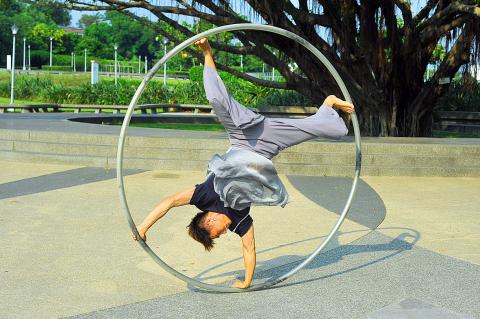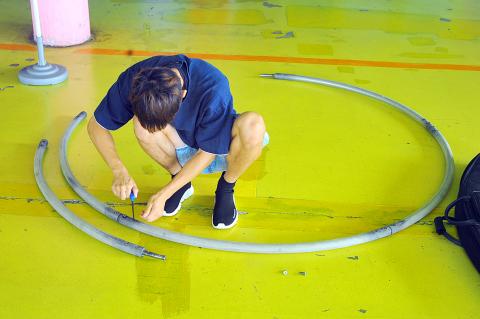With four broken fingers, Yang Shih-hao (楊世豪) lay on the ground in agony for half an hour before his friend discovered him and called an ambulance.
Yang says he couldn’t remember how many times he vomited and how many injuries he had sustained over that first year, but this was the most severe incident so far.
“For the first two years, I felt like the Cyr wheel was controlling me instead of the other way around,” Yang says.

Photo courtesy of Yang shih-hao
The 24-year-old now manipulates the acrobatic apparatus with ease. Yang calmly steps into the large metallic ring, grasping its rims as it starts spinning and rolling. Performing graceful, fluid moves using both hands and feet, it’s hard to tell that the ring weighs 16kg.

Yang recently returned to Taiwan after touring Europe as both festival and street performer. A video of him improvising to Pyotr Tchaikovsky’s Swan Lake at the Avignon Festival recently went viral on Facebook — garnering more than 13 million views and 280,000 shares.

“It was very hectic and noisy there, and suddenly there was this calm performance using such a large apparatus,” Yang says. “I think it was this contrast that grabbed people’s attention.”
FROM HATS TO WHEELS
Re-invented and developed as a circus apparatus in 1996 by Cirque Eloize co-founder Daniel Cyr, the wheel is still an uncommon tool for street performers, Yang says, because it’s hard to transport and master.
“Even in Europe, where there’s a vibrant circus culture, it’s rare to see Cyr wheel performances in public,” Yang says.
During the recent trip, Yang was also invited to a Cyr wheel artist gathering, where he met all of his heroes in one go.
“Three years ago, I was practicing to their videos,” he says. “I couldn’t believe that they all showed up to that gathering.”
As one of Taiwan’s Cyr wheel pioneers, Yang had to learn how to use it on his own. Nobody taught him how to battle the dizziness, so he took motion sickness medicine and pushed through with sheer will. And nobody told him that he had to move his hand otherwise it would be crushed by the wheel — which of course eventually happened.
“I just thought it was fun,” he says. “It’s the sense of accomplishment that kept me going. When I managed to spin for more than 10 seconds, I was beyond excited. I kept telling myself, if the people in the video could do it, so could I. So I persevered.”
A graduate of the National Taiwan College of Performing Arts, Yang originally specialized in hat juggling. The Cyr wheel was just a hobby. But when former Cirque du Soleil performer Chen Hsing-ho (陳星合) invited him to the Weiwuying Arts Festival last year, he asked Yang to bring his wheel and leave the hats at home.
“I said I’d try, but I was perplexed why he didn’t want me to juggle hats,” Yang says. “But when I finished the show, I felt like I saw a new possibility in myself, as if I were a different person. I realized that I should be embracing the many aspects of myself.”
SLOW CIRCLES
Yang usually focuses on practicing before heading abroad to perform, but one can occasionally catch him at the street performance area in Xinyi District (信義) on weekends.
“In Taiwan, there’s a slowly growing circus scene,” he says. “But the difference is that in Europe, you can easily travel to other countries to perform. Here, your options are limited, plus our neighbors do not have much of a scene yet.”
He prefers to remain a street performer as he doesn’t want to be restricted by his troupe or employer, noting that his strong suit is his personal style. He also likes the intimacy of a surrounding crowd.
“Most Cyr wheel performers focus on power while mine is slow. It’s actually harder to slow down. I’ll play very soothing classical music in the background to create a relaxing experience. Audience members often tell me that it was like they just had a dream.”
With an ROC flag on his Cyr wheel case, Yang always tells people where he’s from after each performance.
“Many people actually know the difference between Taiwan and China,” he says. “I don’t need to explain it. But I always mention Taiwan because people ask me anyway.”
As Yang’s craft continues to mature, he hopes to take his personal style further. One idea is to find a way to combine hat juggling with Cyr wheeling. Another is to apply paint to the wheel so it leaves colorful rotation marks on the ground.
“It’s kind of like performance art,” he says. “But I don’t try to convey anything or add any meaning to my art. I simply do it first, and I’ll have a good story later.”

It is a soulful folk song, filled with feeling and history: A love-stricken young man tells God about his hopes and dreams of happiness. Generations of Uighurs, the Turkic ethnic minority in China’s Xinjiang region, have played it at parties and weddings. But today, if they download it, play it or share it online, they risk ending up in prison. Besh pede, a popular Uighur folk ballad, is among dozens of Uighur-language songs that have been deemed “problematic” by Xinjiang authorities, according to a recording of a meeting held by police and other local officials in the historic city of Kashgar in

The Directorate-General of Budget, Accounting and Statistics (DGBAS) told legislators last week that because the Chinese Nationalist Party (KMT) and Taiwan People’s Party (TPP) are continuing to block next year’s budget from passing, the nation could lose 1.5 percent of its GDP growth next year. According to the DGBAS report, officials presented to the legislature, the 2026 budget proposal includes NT$299.2 billion in funding for new projects and funding increases for various government functions. This funding only becomes available when the legislature approves it. The DGBAS estimates that every NT$10 billion in government money not spent shaves 0.05 percent off

Dec. 29 to Jan. 4 Like the Taoist Baode Temple (保德宮) featured in last week’s column, there’s little at first glance to suggest that Taipei’s Independence Presbyterian Church in Xinbeitou (自立長老會新北投教會) has Indigenous roots. One hint is a small sign on the facade reading “Ketagalan Presbyterian Mission Association” — Ketagalan being an collective term for the Pingpu (plains Indigenous) groups who once inhabited much of northern Taiwan. Inside, a display on the back wall introduces the congregation’s founder Pan Shui-tu (潘水土), a member of the Pingpu settlement of Kipatauw, and provides information about the Ketagalan and their early involvement with Christianity. Most

The People’s Republic of China (PRC) was out in force in the Taiwan Strait this week, threatening Taiwan with live-fire exercises, aircraft incursions and tedious claims to ownership. The reaction to the PRC’s blockade and decapitation strike exercises offer numerous lessons, if only we are willing to be taught. Reading the commentary on PRC behavior is like reading Bible interpretation across a range of Christian denominations: the text is recast to mean what the interpreter wants it to mean. Many PRC believers contended that the drills, obviously scheduled in advance, were aimed at the recent arms offer to Taiwan by the